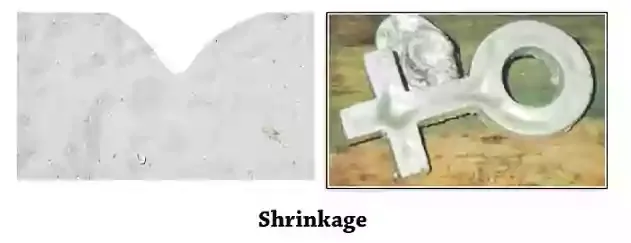Casting Defects & its Remedies
Defects in casting:
There are numerous opportunities for things to go wrong in a casting operation, resulting in quality defects in the cast product. Defects may occur due to one or more of the following reasons:
•Fault in design of casting pattern.
•Fault in design on mold and core.
•Fault in design of gating system and riser.
•Improper choice of molding sand.
•Improper metal composition.
•Inadequate melting temperature and rate of pouring.
Misrun:
Misruns is a casting that has solidified due to improper temperature before completely
Misruns is a casting that has solidified due to improper temperature before completely
filling the mold cavity.
Causes:
•Pouring temperature is too low.
•Cross section of the mold cavity is too thin.
Remedies:
•Maintain the pouring temperature.
•Improve gating system.
Cold Shut:
Lack of fusion between two portions of the metal flow together.
Causes:
•Fluidity of the molten metal is insufficient.
•Cross section of the mold cavity is thin.
Remedies:
•Sufficient fluidity of molten metal.
•Maintain the pouring temperature.
•Improve gating system.
Hot tear:
Hot tear is the crack in the casting caused by high residual stresses.
Causes:
•Casting is poorly designed.
•No proper fillets and corner radii are provided.
Remedies:
•Improved design.
•Proper solidification.
•Even rate of cooling.
Flash:
A thin web or fin of metal on a casting which occurs at die partings, vents and around moveable cores. This excess meta] is due to working and operating clearances in a die.
Causes:
•Excess metal injected to the die.
•Excess operating clearances in a die.
Remedies:
•Measured quantity of the metal to be inject.
•Proper operating clearance in the die.
Shift or Mismatch defect:
Mismatch is categorized as geometric defect as it affects the size, dimensions and geometry of the component. Mismatch in mold defect is because of the shifting molding flashes. It will cause the dislocation of the mould.
Causes:
•Worn-out or bent clamping pins.
•Misalignment of two halves of pattern.
•Improper support of core.
•Improper location of core.
•Faulty core boxes and core.
•Insufficient strength of molding sand and core.
Remedies:
•Repair or replace the pins, for removing defect.
•Repair or replace dowels which cause misalignment.
•Provide adequate support to core.
•Increase strength of both mold.
Shrinkage:
Shrinkage is depression in the casting caused mainly by uncontrolled solidification.
Causes:
•Pouring temperature is too high.
•Improper use of Riser.
Remedies:
•Maintain the molten metal temperature.
•Proper die design.
Blow Defect:
Blow is relatively large cavity produced by gases which displace molten metal from convex surface.
Causes:
•Release of mould gases during pouring.
•Low permeability.
•Poor venting.
•High moisture content in sand.
Remedies:
•Improve vent holes in casting.
•Maintain the moisture content.
Drop Defect:
Drop is an
irregularly shaped projection on the cope surface caused by dropping of sand
Causes.
Causes:
•Low
strength of mould.
•Soft
ramming of the sand.
Remedies:
•Increase
the strength of the mould.
•Proper
ramming of the mould.
Scab Defect:
A scab occurs when an up heaved sand gets separated from the mould surface and the molten metal flows between the displaced sand and the mold.
Causes:
•Using too fine sand.
•Low permeability and low moisture content in sand.
•Uneven ramming.
Remedies:
•Maintain the moister content.
•Proper ramming of the mould.
Penetration:
Penetration occurs when the molten metal flows between the sand particles in the mould.
Causes:
•Low strength of mould.
•Large grain size of sand.
•Soft ramming of sand.
Remedies:
•Maintain the strength of the mould.
•Proper ramming of the mould.
Warpage:
Warpage is undesirable deformation in a casting that occurs during or after solidification.
Causes:
•Due to different rates of solidification different section of a casting, stresses are set up in adjoining walls resulting in warpage in these areas.
•Large and flat sections or intersecting sections such as ribs are particularly prone to warpage.
Remedies:
•Produce large areas with wavy, corrugated construction.
•Proper casting design.
Blow Holes:
Small holes below the surface of a casting caused by entrapped bubbles of gases.
Causes:
•Excessive moisture in sand.
•Low permeability of sand.
•Insufficient Venting.
Remedies:
•Well adjusted moisture content in sand.
•Proper grain size should be used.
•Venting should be adequate.
Porosity:
Large number of uniformly distributed trapped gas resulting in shrinkage during solidification.
Causes:
•Localized solidification shrinkage.
•Freezing manner of the alloy.
Remedies:
•Maintain the die temperature.
•Maintain the molten metal temperature.
Pin hole:
Pin Holes are tiny blow holes appearing just below the casting surface.
Causes:
•High moisture content in moulding sand.
•Absorption of hydrogen or carbon monoxide gas.
Remedies:
•Maintain the moisture content in moulding sand.
END





















0 Comments